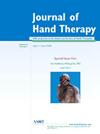Orthotic interventions for restoring proximal interphalangeal joint motion for patients with hand injuries or conditions: A systematic review and meta-analysis
IF 2.1
4区 医学
Q2 ORTHOPEDICS
引用次数: 0
Abstract
Background
Limitations to proximal interphalangeal joint (PIPJ) motion can result in significant functional impairment for people with hand injuries and conditions. The role of orthotic intervention to improve PIPJ motion has been studied; however, high-quality systematic reviews and meta-analyses are lacking.
Purpose
This study aimed to determine the effectiveness of orthotic intervention for restoring PIPJ extension/flexion following hand injuries or conditions.
Study design
Systematic review.
Methods
A comprehensive literature search was completed in MEDLINE, CINAHL, Embase, Cochrane Central, and PEDro using terms related to orthoses, finger PIPJ range of motion, and randomized controlled trial design. Methodological quality was assessed using the PEDro score, study outcomes were pooled wherever possible using random effects meta-analysis, and certainty of evidence was evaluated using Grading of Recommendations Assessment, Development and Evaluation.
Results
Twelve trials were included (PEDro score: 4-7/10). The addition of orthotic intervention was not more effective than hand therapy alone following Dupuytren’s release for improving total active extension (mean difference [MD] −2.8°, 95% confidence interval [CI]: −9.6° to 4.0°, p = 0.84), total active flexion (MD −5.8°, 95% CI: −12.7° to 1.2°, p = 0.70), Disability of the Arm, Shoulder and Hand scores (MD 0.4, 95% CI: −2.7 to 3.6, p = 0.79), or patient satisfaction (standardized MD 0.20, 95% CI: −0.49 to 0.09, p = 0.17). Orthotic intervention was more effective than hand therapy alone for improving PIPJ extension for fixed flexion deformities following traumatic finger injury or surgery (MD −16.7°, 95% CI: −20.1° to −13.3°, p < 0.001). No studies evaluated orthotic intervention to improve PIPJ flexion.
Conclusion
The addition of an extension orthosis following procedures to manage Dupuytren’s contracture is no better than hand therapy alone for improving PIPJ extension. In contrast, the addition of a PIPJ extension orthosis in the presence of traumatic PIPJ fixed flexion deformities is more effective for improving PIPJ extension than hand therapy alone. Future studies are needed to evaluate the role of orthotic intervention for improving PIPJ flexion.
用于恢复手部受伤或患病患者近端指间关节运动的矫形干预:系统回顾与荟萃分析。
背景:近端指间关节(PIPJ)活动受限可导致手部受伤和患病者出现严重的功能障碍。目的:本研究旨在确定矫形干预对手部受伤或患病后恢复 PIPJ 伸展/屈曲的有效性:研究设计:系统回顾:在 MEDLINE、CINAHL、Embase、Cochrane Central 和 PEDro 中使用与矫形器、手指 PIPJ 运动范围和随机对照试验设计相关的术语进行了全面的文献检索。方法学质量采用PEDro评分法进行评估,研究结果尽可能采用随机效应荟萃分析法进行汇总,证据的确定性采用建议评估、发展和评价分级法进行评估:结果:共纳入 12 项试验(PEDro 评分:4-7/10)。84)、总主动屈曲(MD -5.8°,95% CI:-12.7°至 1.2°,p = 0.70)、手臂、肩部和手部残疾评分(MD 0.4,95% CI:-2.7 至 3.6,p = 0.79)或患者满意度(标准化 MD 0.20,95% CI:-0.49 至 0.09,p = 0.17)。在对杜普伊特伦挛缩进行治疗后,加用伸展矫形器在改善 PIPJ 伸展方面的效果并不比单纯的手部治疗好。相反,在存在外伤性 PIPJ 固定屈曲畸形的情况下,加用 PIPJ 伸展矫形器在改善 PIPJ 伸展方面的效果要优于单纯的手疗法。未来的研究需要评估矫形器干预对改善 PIPJ 屈曲的作用。
本文章由计算机程序翻译,如有差异,请以英文原文为准。
求助全文
约1分钟内获得全文
求助全文
来源期刊

Journal of Hand Therapy
医学-外科
CiteScore
3.50
自引率
10.00%
发文量
65
审稿时长
19.2 weeks
期刊介绍:
The Journal of Hand Therapy is designed for hand therapists, occupational and physical therapists, and other hand specialists involved in the rehabilitation of disabling hand problems. The Journal functions as a source of education and information by publishing scientific and clinical articles. Regular features include original reports, clinical reviews, case studies, editorials, and book reviews.
 求助内容:
求助内容: 应助结果提醒方式:
应助结果提醒方式:


